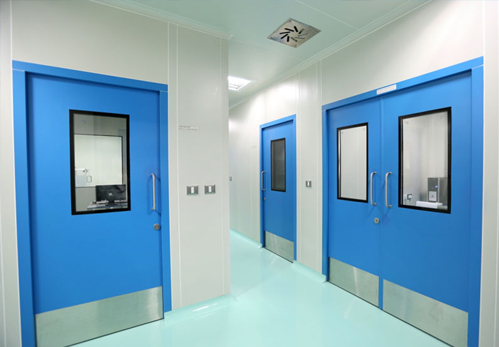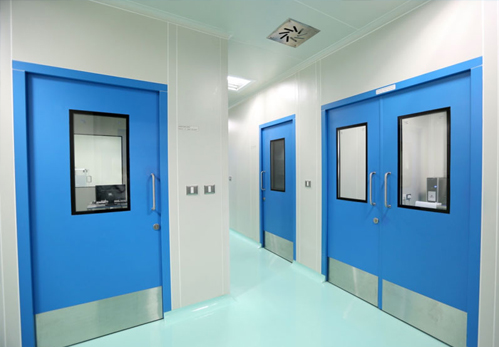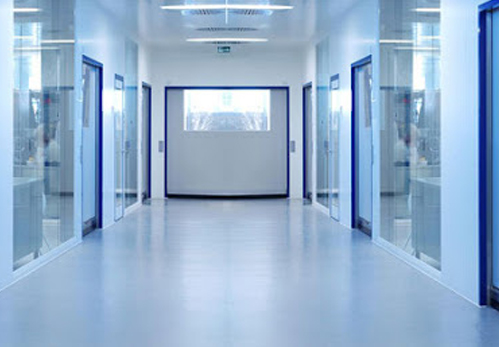A Research Institutes cleanroom is an enclosed zone where airborne particulates and pollutants are maintained at specific levels. The cleanroom is used to filter polluted air as per the requirements of certain industries such as pharmaceuticals, E-liquids, healthcare facilities, as well as science and technology.
The types of impurities that are kept out of the cleanroom through filtering include airborne microbes, dust, chemical vapours, and aerosol particles among others. Our Research Institutes Modular Cleanrooms are developed to meet the required standard of the international organisation for standardisation (ISO) 14644-1: 2015.
Research Institutes Modular Cleanrooms that fall within the standard of the ISO 14644-1:2015 are differentiated by classifications of class 1-9. Cleanrooms can vary between different classifications when the size and level of air particulates change. Cleanrooms that fall in Class 1 (which is the greatest in the classification) are tested for the smallest air pollutant size and lowest frequency while Class 9 cleanrooms are tested for a larger air particulate size range and higher frequency.

Particle counters are employed as the test method for classifying Research Institutes Modular Cleanrooms. This method measures the size and quantity of particles using the Particles Per Cubic Metre (PPCMM) unit. The Particles Per Cubic Metre of an (ISO) 14644-1: 2015 Class 9 Modular Cleanroom corresponds to normal atmospheric air with contaminants >5 microns not allowed into the environment. The Class 1 Modular Cleanroom sees to the filtration of much lower air particulate sizes of >0.1 and >0.2 microns, ensuring that the confined space maintains a low level of contamination.
The following is an example of this standard of testing. A Class 7 Cleanroom will be tested for a particulate size of > 0.5 microns with a maximum particle count of 352,000. Modifications will have to be put in place if the Research Institutes Cleanroom does not meet the requirements for this classification.
Contamination-Free Manufacturing
HEPA and ULPA filters are typically used to maintain the clean air environment in Research Institutes Modular Cleanrooms. These filters are scientifically proven to reduce the size and quantity of air particulates entering a cleanroom. When non-filtered air goes through Filter Fan Units (FFUs), a positive pressure area is introduced and maintained in the clean air environment. Contamination is controlled in the clean air environment by means of the positive pressure as it prevents non-filtered air from flowing back into the cleanroom through exhaust openings.
Pollution-free manufacturing is fostered through the mechanism of the aforementioned type of Research Institutes cleanroom as it only allows the air that passes through the filtration unit to enter the internal space.

Modular Cleanroom Benefits
- Modular Construction
- Quick Assembly Time
- Versatility
- Reconfiguration
- Airflow Control
- Inexpensive Modifications
The Research Institutes Cleanroom mechanism will mitigate the possibility of product contamination. It’s also the first stage of putting a clean air production area in place. The second steps that should be taken in mitigating contamination are measures that will avoid cleanroom personnel from bringing in pollutants. This can be achieved through the proper use of PPE for cleanrooms such as hair nets, overshoes, and gowning. Fibres and other potential pollutants entering the cleanroom will be further reduced as a result, allowing production and research to go on without interference. Personnel has to be taught pollution reduction techniques that will ensure required levels of contaminants in the cleanroom are maintained.
Cleanroom Design, Build & Validation
- Budgeting and planning
- Engineering, design & layout
- Airflow and filtration design
- Construction and Installation
- Full Certification of our product
- Industry-specific equipment installation
- Validation
Saakvee Technologies And Pharmaceuticals Industry

At Saakvee, we build Research Institutes Modular Cleanrooms of the highest standard by employing our experience of over thirty years and our expert engineers. Our Research Institutes Modular Cleanrooms have an outstanding history of build quality, durability and reliability. To ensure we provide projects that satisfy the needs of our customers, our managers at Saakvee supervise every process from start to finish. We oversee the design and installation process which makes us provide one of the best Cleanroom solutions in the world.
We derive fulfilment in providing the latest and best technologies, from efficient Engineering Grade aluminium to ultra-bright LED panelling to see your productivity grow. All our Modular Cleanroom solutions come with a five-year warranty, which is a testament of our confidence in the products we deliver.
Industry Requirements
Cleanrooms are a critical part of the research and production processes in certain industries to ensure contamination-free production.
The use of air filtration in keeping out a certain number of air particulates makes the Cleanroom vital for maintaining a clean air space. Industries where the use of Cleanrooms is needed include Science and Technology, research, electronics, food production, medicine and more.

Rest assured that, with saakvee, you’re only spending for exactly what you need. We can provide guidance concerning ideal Research Institutes Cleanroom standards for you if you’re unsure about anything.
All our Research Institutes Modular Cleanrooms are designed to satisfy the requirements of the ISO 14644-1: 2015. These Cleanrooms range between ISO 1 and 9 classifications. These Cleanrooms will be placed in the class where it satisfies the required number and size of particulates present for any class. ISO 1 Cleanrooms, which are the highest classification, are valued based on having the least number and sizes of particulates while the lowest class (ISO 9), will be evaluated based on the larger quantities and a higher presence of air particulates in the enclosed space.
Particle counters are used to determine the classification of Research Institutes Modular Cleanrooms by assessing their Particles Per Cubic Metre (PPCM). The number, as well as size, of air particulates in the cleanroom are measured by particle counters. ISO 1 rated cleanrooms are evaluated for the extraction of small air particulates >0.1 microns and >0.2 microns whereas an ISO 9 cleanroom, which has a similar PPCM to suburban air, will be tested for the removal of larger air contaminants >5 microns.
Modular Cleanroom Services
- Design & Build
- Free Site Survey
- Free Design Service
- Cleanroom Planning
- Construction and Installation
- CNC Engineered
- Training & Support
- Discounted Service Contracts
- Remedial Works
- Panel Repairs
- Alternations
- BMS Management
- Cleanroom Certification
- Differential Pressure Qualification
- Servicing Testing Validation
- Smoke Testing
- DOP Testing
Containment Solutions

Containment solutions are important in situations where dangerous air particulates that emanate from the production process need to be prevented from contaminating the outside air. This can be achieved in a Modular Cleanroom with the capability to protect production processes by letting in filtered air and prevent dangerous materials from leaving through the use of carbon filters, ULPA (Ultra-Low Particulate Air), or HEPA (High-Efficiency Particulate Air). At Saakvee, we can provide the solution to your containment needs preventing the exposure of hazardous chemicals to the outside atmosphere with the aim to help you become ever more compliant with your regulators.
The containment solutions which we deliver are uniquely built due to the fact that dangerous substances vary according to output and size. This means that the level of containment can change from customer to customer. We will always work closely with you to provide a system that ideally suits your needs.
Airflow And Filtration
Our Cleanrooms are designed to be compliant to the specified ISO 14644-1:2015 grading. With this in mind, we take into consideration the level of air filtration required and the end function of the cleanroom. The level of air filtration required is determined by the air changes per hour (ACH), this determines how many Filter Fan Units are to be used in the cleanroom. What we also determine by the strategic positioning of the FFUs and exhausts is the flow of air around the cleanroom. This can mean the difference between a uni-directional (laminar flow) and a non-unidirectional (turbulent flow) airflow around a cleanroom, potentially leading to a contaminated product. With this in mind, we can greatly increase the number of ACH and control the air flow within the cleanroom.
Filtration of air is controlled by our ultra-quiet, high-efficiency filtration modules. These filtration modules automatically compensate for a build-up of dust and other materials that occur over time within a HEPA/ULPA filter increasing the fan speed to reach the set flow rate. This increases the life of the filter, reducing cost overtime for the end user.
Cleanroom Features
- GMP
- ISO 4-9
- ISO 14644
- Low Power Consumption
- Environmentally Friendly
- HEPA Filters
- Air Filtration
- Fan Filter Units
- Cleanroom Ceiling System
- Temperature Control
- Access Control
- Inter Lock Door Systems
- Air Showers
- Unidirectional Airflow
- Desiccator Cabinets
- Horizontal Flow Wall Modules
- Horizontal Laminar Flow Clean Benches
- Laminar flow cabinets
- Laminar Flow Canopy
Cleanrooms Customised To Your Needs
At Saakvee Technologies there is no such thing as a standard modular cleanroom. Each Cleanroom we design is made to fit your unique work conditions and is designed with your needs in mind. We make each modular Cleanroom to order and make you part of the design process.
With Saakvee Technologies you have the option of doing almost anything with a cleanroom design. This means that your Cleanroom can be many shapes and sizes fitting the most obscure of rooms and can have a range of finishes. We have yet to find a design that we could not accommodate.

Our customisable options mean that all components of the Cleanroom such as doors, windows, lighting, ceilings and filtrations can be altered to better suit your needs. You also have the option of installing furniture, air showers, pass through chambers, fire suppression, air-conditioning and much, much more. We pride ourselves in being able to meet design requests however unique in shape and size they may be.
